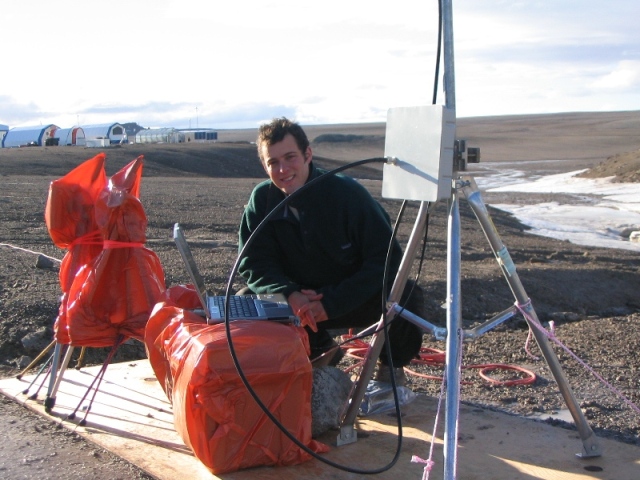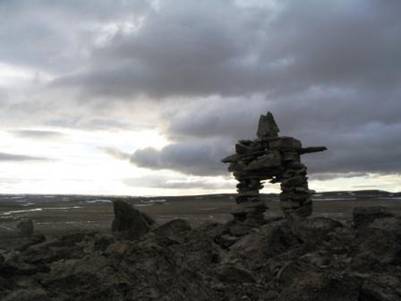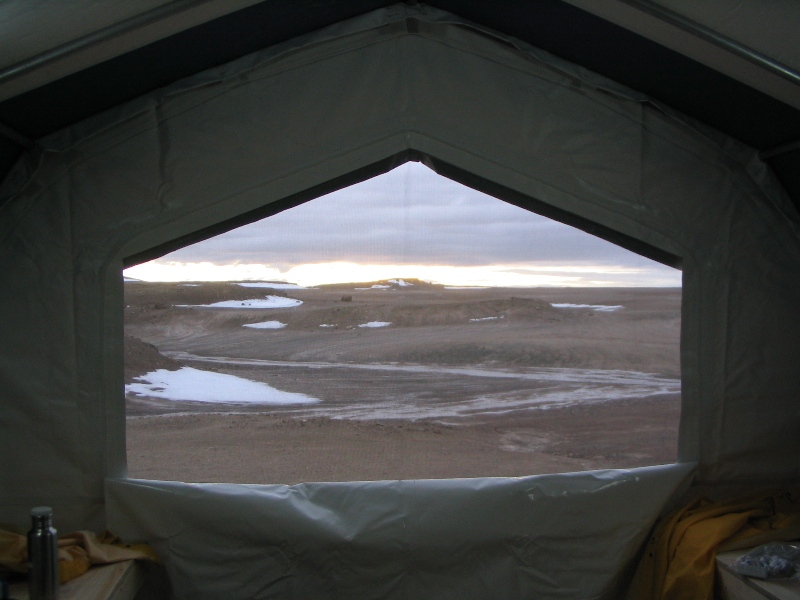HMP e-Logbook
As the field season progressed, the MIT team recorded and posted daily a record of their activities, along with a few selected photos.
The field site's logbook has been duplicated here.
July: 8 10 11 12 14 15 16 17 18 19 20 21 22 23 24 25 26 27 28 29 30 31 August: 1 2 3 4-6
July 21, 2005
Written by Matthew Silver
The wind changed last night, blew away the snow, and the weather became beautifully sunny and mild. Everyone at camp was overjoyed and spirits are definitely up. We took advantage of the change to set up the ATV gate experiment, which we hope to run from tomorrow afternoon to the end of camp. The basic goal of the experiment is simply to monitor ATV traffic across the airport road using battery assisted passive tags which radiate at 2450 mhz. The implications are beyond ATV traffic, and this is mainly to verify the technology. As previously noted, the high frequency can interfere with camp radio transmissions, so we set the gate up outside and relayed it into the network through a transceiver on Comm Hill. Below is a picture of Matt with the experiment and also with, for some reason, a receding hairline. It is important to note, from the author's perspective at least, that the latter does not really exist and seems to have been cause by an extreme case of hat-head. The former, on the other hand, is up and running. You can see base camp behind Matt in the picture. From right to left this includes: the greenhouse solar voltaic cells, the greenhouse itself, Steve's comms tent, and finally the newly erected office tent on the far left. The white tent with orange edges is a temporary food tent.

Again for this experiment Mike worked through the software application and Matt configured the hardware. We saved a lot of time by communicating from this site to the MIT tent via walkie-talkies that our team brought up. The antennas and reader were covered in multiple layers of plastics to ensure that they do not short out when the weather turns again. Everything was placed on 1/2 plywood board, generously provided by the cap carpenter, A.C. Hitch. In case of wind, the tripods were kept tight to the board using bungee chords and guy-lines. On the far left are the two antennas. The plastic box in the middle houses the reader, cables, and the switch for the radio antenna, which is on the right. This antenna was provided by Steve Braham, and points towards Comm hill slightly upwards and the left of the picture. Tomorrow we plan to test tag locations on ATVs in the morning, before installing the tags and beginning the tracking. The battery assisted tags have the advantage of being housed in hard plastic, so they are more rugged. They also have a much longer read range—up to 30 meters—and have more memory and generally more functionality. In fact, these tags could be equipped with many different kinds of sensors, including temperature.
After dinner some of us decided to take advantage of the sun and walk to an Inukchuk, about 3 kilometers North of camp. Inukchuks are piles of stone formed like humans, that the Inuit build to mark their way. They are also a symbol of The North, and are on the flag for the territory of Nunavut. This particular Inukchuk was built by HMP participants a few years ago, as a tribute to the seven astronauts who perished in the Columbia tragedy. Seven human-size Inukchuks were thus built around the area. Below is a picture of the Inukchuck, taken at about 10:30pm.

I should also noted that the MIT tent is now up and running great. There is even a window out the back, that can be unzipped to reveal a brilliant view of the night sun. Oli noted that the tent would be an excellent location from which to launch robotic test vehicles in future years. The picture below was taken at about midnight, out the back window. The sun is not set—it never does in the summer here—but is behind the clouds which have just passed overhead.


